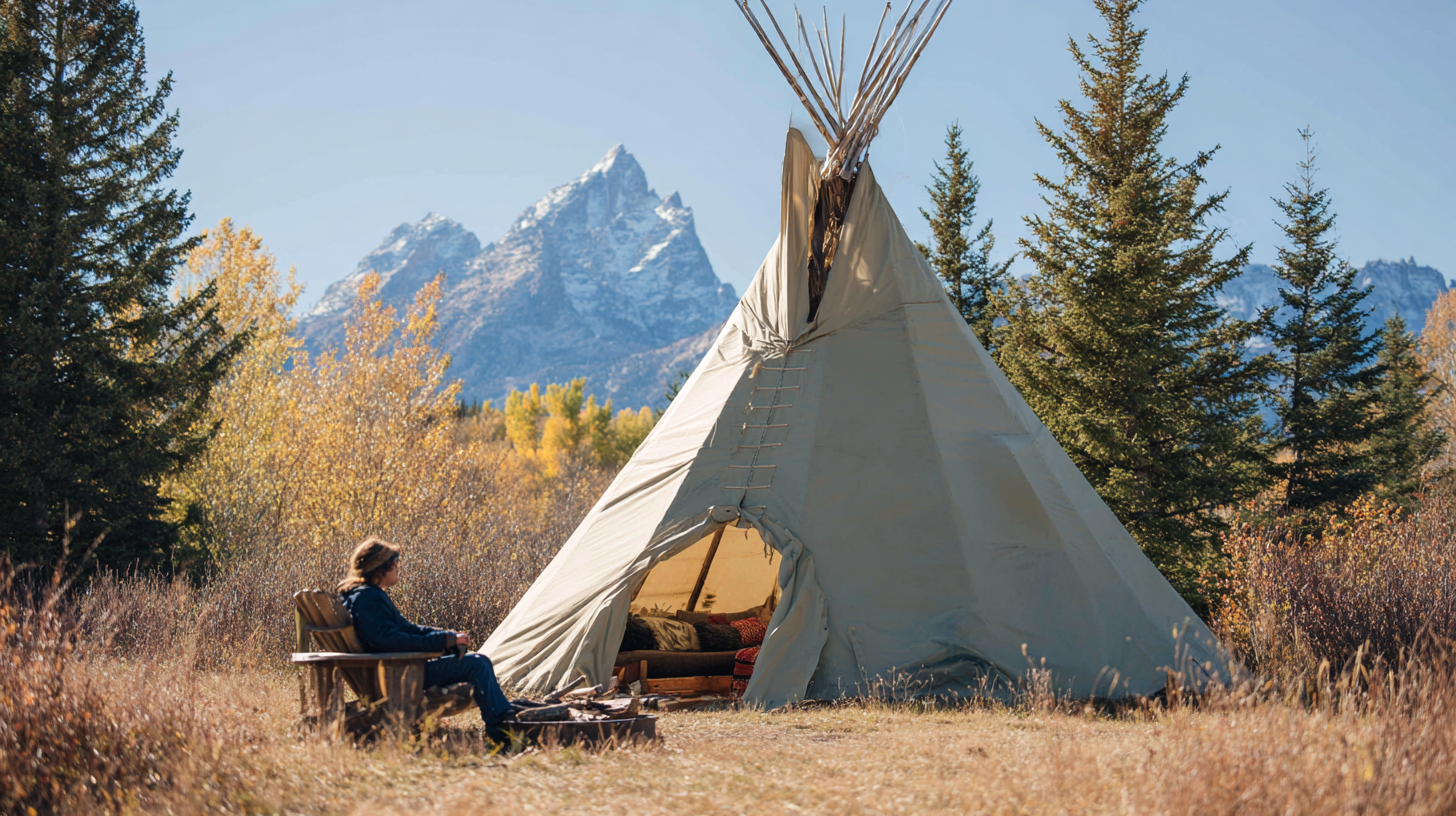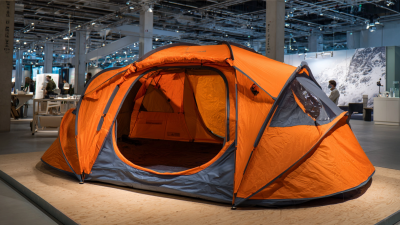Leave Your Message
-
E-mail
-
Whatsapp
In recent years, outdoor enthusiasts have increasingly sought sustainable and eco-friendly camping options that harmonize with nature while providing comfort and practicality. One such choice gaining popularity is Tipi Tents, a traditional dwelling that offers a unique blend of efficiency and aesthetic appeal. These conical-shaped tents, inspired by Indigenous cultures, not only boast excellent weather resistance and spacious interior layouts but also promote a minimal environmental footprint.
 As adventurers look for ways to connect with their surroundings without compromising on comfort, Tipi Tents present a perfect solution that marries functionality with respect for the planet. This guide will explore the various benefits of Tipi Tents, showcasing why they are an ideal choice for unforgettable outdoor adventures.
As adventurers look for ways to connect with their surroundings without compromising on comfort, Tipi Tents present a perfect solution that marries functionality with respect for the planet. This guide will explore the various benefits of Tipi Tents, showcasing why they are an ideal choice for unforgettable outdoor adventures.
Tipi tents, rooted in indigenous culture, boast a unique design that makes them particularly well-suited for outdoor adventures. Their conical shape ensures excellent wind resistance, allowing them to withstand varying weather conditions, from gusty storms to gentle breezes. The tall peak provides ample ventilation, which can prevent condensation buildup, ensuring a comfortable atmosphere even during humid nights. The spacious interior allows for efficient heat retention, effectively utilizing a central fire for warmth while encouraging an inviting gathering space.
The materials used in constructing tipis enhance their functionality and sustainability. Traditionally crafted from natural resources, modern iterations often incorporate eco-friendly fabrics that resist wear and tear while minimizing environmental impact. The adaptability of tipi tents allows for easy setup and breakdown, making them an ideal choice for camping enthusiasts seeking versatile shelter that can be transported with ease. This distinctive combination of design and practicality makes tipis a compelling option for anyone looking to connect with nature while enjoying the comforts of innovative shelter technology.
When evaluating the environmental impact of tipi tents versus traditional camping gear, a few key factors come into play, including materials used, production processes, and overall sustainability. Tipi tents, often constructed from natural fibers such as canvas or wool, are biodegradable and have a lower carbon footprint compared to synthetic materials commonly found in tents and gear, which may take hundreds of years to decompose. This use of natural materials not only reduces waste but also minimizes the energy required for production, setting tipi tents apart as a more eco-friendly option for outdoor enthusiasts.
Furthermore, the design of tipi tents promotes energy efficiency. Their conical shape allows for better heat retention and natural ventilation, reducing the need for artificial heating or cooling during use. In contrast, many traditional tents may rely on multi-layer synthetic designs that contribute to excess energy consumption and environmental strain during production. As outdoor adventurers seek ways to lessen their ecological footprint, the impact of their gear becomes increasingly important, making tipi tents a sustainable choice that aligns with responsible camping practices and a deeper appreciation for nature.
| Feature | Tipi Tents | Traditional Camping Gear |
|---|---|---|
| Material Sustainability | Often made from natural, biodegradable materials | Typically made from synthetic, non-biodegradable materials |
| Carbon Footprint | Lower, due to sustainable manufacturing and reusable nature | Higher, from non-sustainable materials and one-time use |
| Setup Time | Relatively quick and easy to set up | Can take longer, especially for complex structures |
| Space & Comfort | More spacious and allows for better air circulation | Often more cramped, limited headspace |
| Weather Resistance | Excellent performance in diverse weather conditions | Varies widely; some are less resilient |
| Portability | Generally lightweight and easy to carry | Can be bulky and heavy depending on the design |
When setting up your tipi tent for an enjoyable outdoor experience, selecting the right location is crucial. Opt for a flat, dry area that offers some natural protection from the wind and sun. Ensure the ground is free of rocks and debris to create a comfortable base. Using a ground tarp not only provides an additional layer of insulation but also extends the lifespan of your tent by protecting it from moisture and wear.
Once your site is chosen, assembling the tipi requires careful attention to detail. Begin by adequately staking down the corners to secure the tent against the elements. This is particularly important in windy conditions. As you raise the central pole, ensure that the fabric is evenly distributed around it to maintain its shape and stability. Don’t forget to ventilate your tipi properly; leaving a small gap at the top will help with air circulation, preventing condensation inside. By following these tips, you can create a cozy and welcoming atmosphere within your tipi, making your outdoor adventure even more enjoyable.
When it comes to choosing the right location for pitching your tipi tent, several factors come into play to ensure a memorable outdoor experience. According to a report by the Outdoor Industry Association, 57% of outdoor enthusiasts prioritize comfort and accessibility in their camping locations. This statistic underscores the importance of selecting spots that not only provide stunning views but are also easy to reach, allowing for a seamless setup of your tipi tent.

Looking for ideal spots? Consider locations near serene lakes or lush forest areas. These places not only offer captivating landscapes but also help in maintaining the sustainable ethos associated with tipi tents. The World Wildlife Fund highlights that camping in areas with minimal human impact can significantly reduce your carbon footprint, making your outdoor adventures not just enjoyable, but also eco-friendly.
Tip: Always check local guidelines and regulations regarding camping spots to ensure that you’re respecting nature and avoiding prohibited areas. Additionally, scouting your location beforehand can help you understand the terrain and environmental factors like wind patterns, which can influence the stability and comfort of your tipi tent.
Caring for your tipi tent is essential in ensuring its longevity and sustainability. Unlike many modern tents, which often score poorly on sustainability metrics due to their reliance on non-recycled materials, a well-maintained tipi tent can serve as an eco-friendly outdoor option. For instance, studies show that tents incorporating recycled or Bluesign-approved materials significantly reduce their environmental impact. While many car camping tents have been rated at the bottom of sustainability scales, investing in a tipi tent made with natural materials can effectively mitigate this issue.

To extend the lifespan of your tipi tent, regular maintenance is crucial. This includes cleaning the fabric with gentle, environmentally safe solutions to prevent deterioration, and ensuring proper drying to avoid mold. Utilizing correct storage methods, such as keeping the tent in a dry, cool place, can further enhance its durability. The challenges faced by mainstream camping gear, including poor sustainability ratings for many popular models, highlight the benefits of choosing a tipi. With a greater focus on sustainable practices, tipi tents offer an excellent alternative, marrying performance with eco-consciousness, thereby encouraging responsible outdoor adventures.






